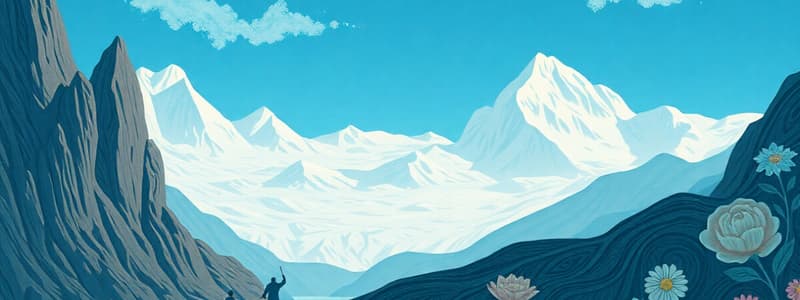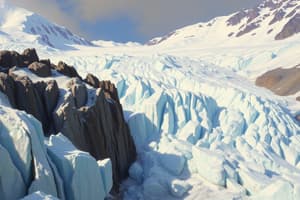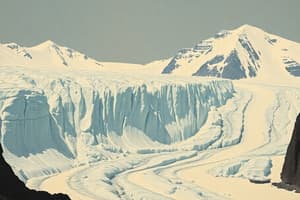Podcast
Questions and Answers
Where is the fastest movement of a glacier most likely to occur?
Where is the fastest movement of a glacier most likely to occur?
- At the edges of the glacier
- In the center of the glacier (correct)
- At the bottom of the glacier
- Near the terminus of the glacier
What happens when a glacier experiences more accumulation than ablation?
What happens when a glacier experiences more accumulation than ablation?
- The glacier is advancing (correct)
- The glacier is retreating
- The glacier is stable
- The glacier is frozen solid
What term describes the physical removal of rock fragments from one location to another?
What term describes the physical removal of rock fragments from one location to another?
- Weathering
- Ascension
- Deposition
- Erosion (correct)
What are glacial erratics?
What are glacial erratics?
What results from the accumulation of sediments carried by meltwater in front of a glacier?
What results from the accumulation of sediments carried by meltwater in front of a glacier?
What defines a glacier?
What defines a glacier?
Where can alpine glaciers be found?
Where can alpine glaciers be found?
What term is used for glaciers that extend out of high elevations into U-shaped valleys?
What term is used for glaciers that extend out of high elevations into U-shaped valleys?
How do continental ice sheets typically behave?
How do continental ice sheets typically behave?
What causes the land beneath heavy continental ice sheets to sink?
What causes the land beneath heavy continental ice sheets to sink?
What is the term used for the breaking down of rock chemically or physically?
What is the term used for the breaking down of rock chemically or physically?
What must be overcome for an object to move downhill in the presence of gravity?
What must be overcome for an object to move downhill in the presence of gravity?
Which factor does NOT influence the force of friction on a slope?
Which factor does NOT influence the force of friction on a slope?
What effect does increasing the steepness of a hillside have on the weight component along the surface?
What effect does increasing the steepness of a hillside have on the weight component along the surface?
What happens when the weight component along a surface exceeds the frictional force?
What happens when the weight component along a surface exceeds the frictional force?
What is the slowest type of mass movement called?
What is the slowest type of mass movement called?
Which factor increases the likelihood of mass movement on a hillside?
Which factor increases the likelihood of mass movement on a hillside?
What type of mass movement occurs when water content is high and causes surface material to liquefy?
What type of mass movement occurs when water content is high and causes surface material to liquefy?
Which of the following can trigger mass movement on a hillside?
Which of the following can trigger mass movement on a hillside?
What is a talus slope?
What is a talus slope?
What is the primary driving force behind all types of mass movement?
What is the primary driving force behind all types of mass movement?
Which term describes the critical angle at which material starts to slide on a slope?
Which term describes the critical angle at which material starts to slide on a slope?
Which of the following factors does NOT contribute to the triggering of landslides?
Which of the following factors does NOT contribute to the triggering of landslides?
What type of motion occurs in landslides when material falls freely from a steep slope or cliff?
What type of motion occurs in landslides when material falls freely from a steep slope or cliff?
How can water affect mass movement, according to the content provided?
How can water affect mass movement, according to the content provided?
Flashcards
What is a glacier?
What is a glacier?
A large mass of ice that accumulates on land over years of snowfall and moves under its own weight.
What are alpine glaciers?
What are alpine glaciers?
Glaciers that form in high mountains, often carving U-shaped valleys.
What are continental ice sheets?
What are continental ice sheets?
Vast sheets of ice covering continents, like Greenland and Antarctica.
What are tidewater glaciers?
What are tidewater glaciers?
Signup and view all the flashcards
How do glaciers move?
How do glaciers move?
Signup and view all the flashcards
Glacial Plastic Flow
Glacial Plastic Flow
Signup and view all the flashcards
Glacial Retreat
Glacial Retreat
Signup and view all the flashcards
Weathering
Weathering
Signup and view all the flashcards
Erosion
Erosion
Signup and view all the flashcards
Terminal Moraine
Terminal Moraine
Signup and view all the flashcards
Gravity
Gravity
Signup and view all the flashcards
Friction
Friction
Signup and view all the flashcards
Weight Component
Weight Component
Signup and view all the flashcards
Critical Angle
Critical Angle
Signup and view all the flashcards
What is soil creep?
What is soil creep?
Signup and view all the flashcards
What is a rockfall?
What is a rockfall?
Signup and view all the flashcards
What is a slide?
What is a slide?
Signup and view all the flashcards
What is a slump?
What is a slump?
Signup and view all the flashcards
What are flows in mass movement?
What are flows in mass movement?
Signup and view all the flashcards
What is mass movement?
What is mass movement?
Signup and view all the flashcards
What is "fluvial"?
What is "fluvial"?
Signup and view all the flashcards
What is "aeolian"?
What is "aeolian"?
Signup and view all the flashcards
What is the "angle of repose"?
What is the "angle of repose"?
Signup and view all the flashcards
What is a "fall" in mass movement?
What is a "fall" in mass movement?
Signup and view all the flashcards
Study Notes
Glaciers and Glacial Landforms
- Glaciers are large masses of compressed ice, accumulating over years of snowfall, and moving under their own weight.
- Ocean ice is not considered a glacier.
- Glaciers form in high elevations (alpine glaciers) or near polar ice caps (continental ice sheets).
- Alpine glaciers can form near the equator if located at high enough elevations.
- Continental ice sheets (Greenland, Antarctica) are very thick and depress the land beneath them.
- Glaciers move downhill or outward via plastic flow (like silly putty) or sliding on meltwater.
- Plastic flow is slower at the edges due to friction, faster in the center.
- Glacier movement rates vary, from a few meters per year to 100 meters/day (surging glaciers).
- Erosion, weathering, and deposition are all involved in glacial landform creation
Glacier Movement and Types
- Valley glaciers carve U-shaped valleys extending from high elevations.
- Ice fields are glaciers filling the area between peaks.
- Tidewater glaciers meet the ocean.
- Piedmont glaciers extend onto flat land, not the ocean.
- Glacier movement depends on accumulation (snow gain) and ablation (snow loss).
- Advancing glaciers are growing; retreating glaciers are shrinking.
- Glaciers are constantly moving outward, like conveyor belts
Glacial Weathering and Erosion
- Glaciers weather and erode rocks through frost wedging (water freezing expands cracks) and abrasion (rock fragments grind surfaces).
- Glaciers transport weathered rock fragments, pushing and dropping them (deposition).
- Glacial deposits (poorly sorted) are characterized by angular grains of all sizes (from mud to boulders)
Glacial Landforms
- Moraines: piles of glacial sediment (lateral, terminal, ground, medial).
- Glacial erratics: large, isolated rocks left by glaciers.
- Drumlins: mounds shaped by advancing glaciers over ground moraines.
- Outwash plains: plains of sediment deposited by meltwater in front of glaciers.
- Eskers: raised river beds carved by meltwater beneath glaciers, visible after retreat.
- U-shaped valleys: glaciers carve valleys with steep sides.
- Cirques: bowl-shaped depressions carved at the top of glacial valleys.
- Hanging valleys: smaller tributary valleys that "hang" above the main valley below.
- Arêtes: thin, sharp ridges carved between parallel valleys.
- Horns: sharp peaks formed where multiple cirques meet.
- Fjords: U-shaped valleys flooded with seawater.
Glacial Impacts and Cycles
- Glaciers cover roughly 10% of Earth's land surface today and 30% during the last ice age.
- Evidence of past glaciation includes moraines, striations, lake sediments.
- Ice ages are periods when glaciers advance, while interglacials are periods of retreat.
- Ice ages are influenced by small changes in Earth's tilt, solar energy, greenhouse gases, and ocean currents.
- Greenhouse gases like water vapor, CO2 and methane trap heat in the Earth's atmosphere.
- Increased levels of greenhouse gases lead to warmer temperatures, while decreased levels lead to colder temperatures.
- Glaciers' retreat and advance affect sea levels, climate zones, and agriculture.
Mass Movement
- Mass movement (mass wasting or landslides) is the downhill movement of soil or rock due to gravity.
- Water doesn't drive mass movement. Fluvial processes involve water, aeolian involve wind.
- Water can intensify mass movement, such as in debris flows or hyper-concentrated flows.
- Landslides are a general term; geologists use specific classifications.
- Landslides are categorized by material type, motion type, and motion rate.
- Gravity is the driving force.
- The angle of repose is the critical angle where material slides.
- Slope stability is influenced by factors like weathering, water, human activities (e.g., road construction), and geological structure.
- Types of motion include: falls (e.g., bedrock falling); slides (rotational, translational); flows (chaotic, fluid-like).
- Debris flows are a type of mass movement with a mixture of water, mud, and boulders.
- Mudflows are a subset of flows, involving finer materials.
- Avalanches involve dry material (snow or rock).
- Subsidence occurs when ground collapses from support removal (e.g., water erosion, groundwater pumping).
- Sinkholes are a common example of subsidence.
- Lahars are volcanic mudflows.
- Understanding mass movement is critical for risk mitigation.
Studying That Suits You
Use AI to generate personalized quizzes and flashcards to suit your learning preferences.




